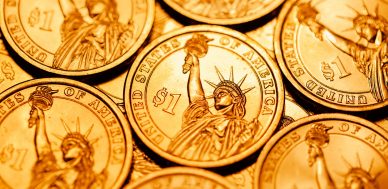The Gold Price Forecast for the Next Three Months
After a complex 2017 for the yellow metal, gold price predictions in 2018 should become clearer. The reason is that Bitcoin and other cryptocurrencies have started to lose their shine even faster than they found it. There were even suggestions that Bitcoin could become a “reserve currency,” as if it were some kind of new gold bullion. However, that it is not. And investors are starting to realize this, judging by Bitcoin’s performance since the start of the year.
All things considered, gold should have had a great year in 2017. The higher frequency and success of North Korean nuclear-capable rocket launches, last year, culminated in a false-alarm in Hawaii that had the entire county on edge. Then there are matters ranging from the other geopolitical crises in the Middle East, Russia, and China to the less-than-self-assured way President Donald Trump has taken to the Oval Office. Meanwhile, central banks in Europe and the United States were keen to revive plans to raise interest rates. However, they proved less inclined to take the risk and do much about it.
In the United States, which has just approved a massive corporate tax cut, it won’t be easy to raise interest rates. Until the logic of the tax plan works–that is, the government will collect more taxes because companies will invest more and hire more workers/taxpayers–raising the rates is a gamble for the U.S. national debt, which stands at $20.0 trillion. That means that interest alone costs over $200.0 billion.
Gold Prices in the First Quarter
Certainly, gold at the start of 2018 shows bullish signs. As of mid-January, the gold price per ounce is already comfortably above $1,300; the gold price today was $1,340, which almost as high as it was in September, in the thick of North Korean missile tests. More than 2017, geopolitical factors could make the difference in 2018. Remember that in mid-November, $1,300 was the ceiling price for gold. Now, the ceiling is $1,400.
Goldman Sachs Group Inc (NYSE:GS), for example, sees gold prices as falling for the first quarter of 2018 and only picking up at the end, heading to $1,375 an ounce in 2020. So far, in the first two weeks of 2018, gold has already forced Goldman Sachs to change its outlook, given that it’s just a bit shy of the price it forecast for 2020. (Source: “Goldman: Gold Prices To Fall Into Mid-2018, Rally Into 2020,” Kitco Inc., December 20, 2017.)
Bearish gold analysts cite the fact that the Trump tax cuts will boost economic growth and employment, forcing the Federal Reserve to raise interest rates and increase the value of the dollar. And it’s true that, typically, high interest rates have not supported gold prices. But that assumes that the tax plan will work like clockwork.
The fact is that the tax cuts leave many uncertainties. Even if inflation does rise, pushing the value of precious metals higher, the Fed will not have as much ability to control it. Trump will discourage too significant a rate hike because doing so puts the performance of the stock market in peril. The Dow seems headed for 26,000, with some even saying 30,000 points at the end of 2018. But interest rates must remain low for that to happen, even if all other factors remain ideal. One rate hike too many could make the whole house of cards collapse.
Gold Price Chart
Courtesy of StockCharts.com
There are important elections coming up that have not been adequately discussed in the United States, focused as it remains on all things “Russiagate.” Indeed, that excessive distraction will catch many investors by surprise, when the real risk knocks at the door.
For instance, Italy, a key member of the European Union, is heading to the polls on March 3. These are the most uncertain elections in decades and several euro-skeptic parties are slated to win. The euro currency could easily pay for the risk that this vote implies. Thus gold prices could start a steady climb over the next three months that should easily bring gold to over $1,400.
North Korea is looking for a solution to its nuclear program independently of the United States. The Olympics in PyeongChang, which begin in February, will offer a chance for a relaxation of tensions, but this will be temporary. North Korea is seeking an improvement of ties with South Korea, yet shall maintain (if it develops the necessary capability) missiles aimed against the United States. Thus, for Washington and Trump, North Korea will remain a conundrum.
Then there’s the question of Iran. The protests in various cities may offer the opportunity for intervention. It would be a mistake to interfere in Iran, and Trump appears to have acknowledged this when he approved the nuclear deal for another six months. However, he threatened that this would be the last such approval.
Thus, by the spring of 2018, if not sooner, Iran will return to the fore as a risk. Moreover, there are growing tensions with Turkey, as Trump announced plans to deploy some 30,000 troops in northern Syria. This would irritate both Turkey (a U.S. and NATO ally) and Russia. In other words, if anyone thought that 2017 ended on a high note for stability, 2018 will show them the meaning of “being inestimably wrong.” (Source: “Erdoğan accuses US of planning to form ‘terror army’ in Syria,” The Guardian, January 15, 2018.)
The combination of “Trumpnomics”–that is, the low tax rate-fueled economy–geopolitical tensions, and the probable implosion of Bitcoin (or at least a major correction) make gold a star in 2018. The precious metal has already beaten the forecasts. Many may have been forced to revise their gold price prediction for the next three months, given the tremendous start to the year.
